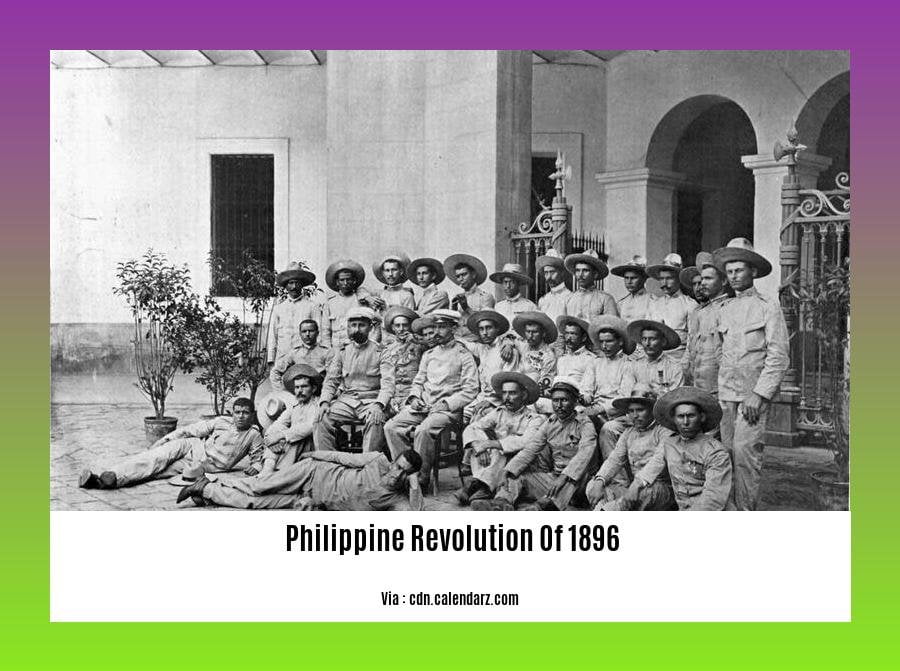[- The Philippine Revolution of 1896: A Turning Point in the Nation’s History]: The Philippine Revolution of 1896 stands as a pivotal moment in the nation’s history, marking a tumultuous chapter in the struggle for independence from Spanish colonial rule. This uprising, fueled by a complex interplay of political, social, and economic factors, would forever alter the course of Philippine history.
Key Takeaways:
- The Philippine Revolution of 1896 sought to gain independence from Spain.
- The Katipunan, a secret revolutionary society, played a pivotal role in sparking the revolt.
- Led by Emilio Aguinaldo, the revolution resulted in the end of Spanish rule in 1898, when the Philippines came under American control.
- The revolution evolved into the Philippine-American War, which continued until 1902.
Philippine Revolution of 1896

The Philippine Revolution of 1896 was a turning point in the nation’s history. It’s the culmination of centuries of Spanish colonial rule and the desire for independence.
Sparks of Revolution
The revolution started with the discovery of the Katipunan, a secret revolutionary society founded by Andres Bonifacio in 1892. Its goal was to overthrow Spanish rule and establish an independent Philippine republic.
The Cry of Balintawak
On August 23, 1896, the Katipuneros tore their cedulas (proof of tax payment to Spain) in Balintawak, officially starting the revolution. Emilio Aguinaldo emerged as the leader and established a revolutionary government.
The Fight for Independence
The revolution quickly spread throughout the Philippines. Filipinos fought valiantly against the Spanish colonial forces, using guerrilla warfare tactics. The Spanish initially suppressed the revolt, but the revolutionaries regrouped and continued to fight.
The Intervention of the United States
In 1898, the United States declared war on Spain after the sinking of the USS Maine in Havana Harbor. The Spanish-American War ended with Spain’s defeat and the Philippines ceded to the United States.
The Philippine-American War
The Philippine Revolution of 1896 didn’t end with the defeat of Spain. The Filipinos continued to fight for independence against the United States, leading to the Philippine-American War (1899-1902). The war ended with the establishment of the United States as the colonial power in the Philippines.
Legacy of the Revolution
The Philippine Revolution of 1896 was a watershed moment in Philippine history. It ignited the spirit of nationalism and paved the way for the country’s eventual independence in 1946. It remains a source of inspiration for Filipinos and a reminder of our nation’s resilience and determination.
Embark on a riveting journey through the annals of the Philippines, where you can delve into its rich and storied history. Step into the History of the Philippines, marked by pivotal moments and the indomitable spirit of its people. Explore the Spanish colonization that shaped the nation’s culture and identity, leaving an enduring legacy. Witness the transformative events of the Martial Law and People Power Revolution, a testament to the Filipinos’ unyielding resilience and determination.
Impact of the Revolution on Philippine History

The Philippine Revolution of 1896 transformed the trajectory of the nation, forever altering its political landscape.
Awakening National Consciousness:
The revolution sparked a profound sense of Filipino nationalism, igniting a desire for self-determination. Filipinos rose against Spanish oppression, demanding their inherent right to govern themselves.
Shattering Spanish Colonial Rule:
The revolution shook the foundations of Spanish colonialism, forcing the foreign power to confront the growing aspirations of the Filipino people. It proved that the resilience of a united nation could challenge imperial dominance.
Unveiling Filipino Courage and Leadership:
The revolution showcased the indomitable spirit of Filipinos. Leaders like Andres Bonifacio, Emilio Aguinaldo, and others symbolized the courage and determination of their people. Their sacrifices and unwavering pursuit of independence left a lasting legacy.
Setting the Stage for Independence:
Although the revolution did not immediately achieve its goal of complete independence, it laid the groundwork for future struggles. It fostered a sense of unity and paved the way for the eventual establishment of the First Philippine Republic in 1898.
Expanding Global Awareness of Filipino Sovereignty:
The revolution brought international attention to the plight of the Philippines, exposing the oppressive nature of Spanish rule and galvanizing support for Filipino aspirations around the world.
Key Takeaways:
- The revolution sparked a profound awakening of Filipino nationalism.
- It challenged Spanish colonial rule, proving the strength of a united people.
- Filipino leaders emerged as symbols of courage and determination.
- The revolution set the stage for future independence struggles.
- It brought global awareness to Filipino sovereignty.
Relevant URL Sources:
– Philippine Revolution | Facts, Leaders, & Significance
– Philippine Revolution – Wikipedia
Role of Key Figures in the Revolution
In the annals of Philippine history, the Revolution of 1896 stands as a pivotal moment that launched the nation on its path to independence. At the helm of this tumultuous chapter were indomitable individuals whose leadership, sacrifice, and strategic acumen left an enduring mark on the country’s destiny.
Key Takeaways:
- Andres Bonifacio: The enigmatic founder of the secret society Katipunan, Bonifacio galvanized the masses with his fiery speeches and unwavering commitment to overthrowing Spanish rule.
- Emilio Aguinaldo: A military tactician and revolutionary leader, Aguinaldo led the Katipuneros in key battles and eventually became the first president of the short-lived Philippine Republic.
- Apolinario Mabini: Known as the “Brains of the Revolution,” Mabini served as Aguinaldo’s adviser and crafted the Malolos Constitution, the first constitution of the Philippines.
These individuals embodied the spirit of resistance and nationhood that fueled the revolution. Their unwavering determination and unwavering belief in a free Philippines inspired countless Filipinos to join the cause.
Citation:
Legacy of the Philippine Revolution of 1896
The Philippine Revolution of 1896, a pivotal uprising against Spanish colonial rule, left an indelible imprint on the nation’s history. Though it did not immediately secure independence, the revolution sparked a chain of events that would ultimately shape the country’s path towards nationhood.
Key Takeaways:
- Awakening of Filipino Nationalism: The revolution ignited the spirit of Filipino nationalism, fostering a newfound sense of unity and identity among its people.
- Inspiration for Future Independence Movements: The revolution’s legacy extended beyond the borders of the Philippines, inspiring other colonized nations to fight for their freedom.
- Basis for Philippine Constitutionalism: The Malolos Constitution, drafted during the revolution, laid the foundation for the Philippines’ future democratic institutions.
- Establishment of a Filipino Identity: The revolution helped forge a distinct Filipino identity, one that was distinct from both Spain and the United States.
- Symbol of Filipino Resilience: The revolution became a testament to the Filipino people’s unwavering determination and resilience in the face of adversity.
Citation:
FAQ
Q1: What sparked the Philippine Revolution of 1896?
A1: The Philippine Revolution of 1896 was sparked by growing Filipino nationalism and discontent, inspired by the works of Jose Rizal, and the discovery of the Katipunan, a Filipino revolutionary society.
Q2: What were the main goals of the Philippine Revolution?
A2: The Philippine Revolution of 1896 aimed to gain independence from Spanish colonial rule and establish a Filipino republic.
Q3: Who were the leaders of the Philippine Revolution?
A3: Key leaders of the Philippine Revolution included Emilio Aguinaldo, Andres Bonifacio, and Apolinario Mabini.
Q4: What were the outcomes of the Philippine Revolution?
A4: The Philippine Revolution led to the end of Spanish colonial rule, but the Philippines did not achieve full independence immediately.
Q5: How did the revolution impact Philippine history?
A5: The Philippine Revolution of 1896 is considered a turning point in Philippine history, as it marked the beginning of the struggle for independence and the eventual establishment of the Philippine republic.












